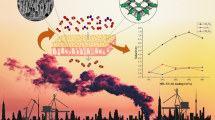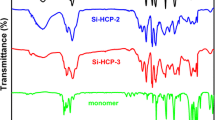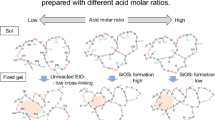Abstract
A Pd-doped organosilica membrane based on bis(triethoxysilyl)ethane is successfully developed by the polymeric sol–gel method. Its microstructure, chemical composition, and separation performance are compared with those of the undoped organosilica membrane. Gas adsorption analysis indicates that the Pd-doped organosilica membrane has larger micropores compared with the undoped organosilica membrane. The gas permeation results show that the Pd-doped organosilica membrane has much higher gas permeances than the undoped organosilica membrane due to the enlarged micropores after Pd-doping. The Pd-doped organosilica membrane also exhibits a significantly improved hydrothermal stability. The enhanced hydrothermal stability can be explained by the mechanism that Pd particles act as inhibitors and prevent the formation of mobile silica groups (e.g., Si–OH) under steam condition. Metal-doping (e.g., Pd-doping in this work) may offer a new approach to develop high performance membranes with enhanced gas permeances and hydrothermal stabilities in gas separation applications.















Similar content being viewed by others
References
Bernardo P, Drioli E, Golemme G (2009) Membrane gas separation: a review/state of the art. Ind Eng Chem Res 48:4638–4663. doi:10.1021/ie8019032
Baker RW (2002) Future directions of membrane gas separation technology. Ind Eng Chem Res 41:1393–1411. doi:10.1021/ie0108088
Ockwig NW, Nenoff TM (2007) Membranes for hydrogen separation. Chem Rev 107:4078–4110. doi:10.1021/cr0501792
Gabelman A, Hwang S-T (1999) Hollow fiber membrane contactors. J Membr Sci 159:61–106. doi:10.1016/s0376-7388(99)00040-x
Luis P, Van Gerven T, Van der Bruggen B (2012) Recent developments in membrane-based technologies for CO2 capture. Prog Energy Combust Sci 38:419–448. doi:10.1016/j.pecs.2012.01.004
Adhikari S, Fernando S (2006) Hydrogen membrane separation techniques. Ind Eng Chem Res 45:875–881. doi:10.1021/ie050644l
Scholes CA, Smith KH, Kentish SE, Stevens GW (2010) CO2 capture from pre-combustion processes—strategies for membrane gas separation. Int J Greenhouse Gas Control 4:739–755. doi:10.1016/j.ijggc.2010.04.001
Dong J, Lin YS, Kanezashi M, Tang Z (2008) Microporous inorganic membranes for high temperature hydrogen purification. J Appl Phys 104:121301–121317. doi:10.1063/1.3041061
de Vos RM, Verweij H (1998) High-selectivity, high-flux silica membranes for gas separation. Science 279:1710–1711. doi:10.1126/science.279.53537.1710
Kanezashi M, Sasaki T, Tawarayama H et al. (2014) Experimental and theoretical study on small gas permeation properties through amorphous silica membranes fabricated at different temperatures. J Phys Chem C 118:20323–20331. doi:10.1021/jp504937t
Gallucci F, Fernandez E, Corengia P, Annaland MV (2013) Recent advances on membranes and membrane reactors for hydrogen production. Chem Eng Sci 92:40–66. doi:10.1016/j.ces.2013.01.008
Pera-Titus M (2014) Porous inorganic membranes for CO2 capture: present and prospects. Chem Rev 114:1413–1492. doi:10.1021/cr400237k
Tsuru T (2008) Nano/subnano-tuning of porous ceramic membranes for molecular separation. J Sol–Gel Sci Technol 46:349–361. doi:10.1007/s10971-008-1712-5
Imai H, Morimoto H, Tominaga A, Hirashima H (1997) Structural changes in sol–gel derived SiO2 and TiO2 films by exposure to water vapor. J Sol–Gel Sci Technol 10:45–54. doi:10.1023/a:1018332221696
Castricum HL, Sah A, Kreiter R, Blank DHA, Vente JF, ten Elshof JE (2008) Hybrid ceramic nanosieves: stabilizing nanopores with organic links. Chem Commun. doi:10.1039/b718082a
Duke MC, da Costa JCD, Do DD, Gray PG, Lu GQ (2006) Hydrothermally robust molecular sieve silica for wet gas separation. Adv Funct Mater 16:1215–1220. doi:10.1002/adfm.200500456
Castricum HL, Mittelmeijer-Hazeleger MC, Sah A, ten Elshof JE (2006) Increasing the hydrothermal stability of mesoporous SiO2 with methylchlorosilanes—a ‘structural’ study. Microporous Mesoporous Mater 88:63–71. doi:10.1016/j.micromeso.2005.08.033
Wei Q, Wang YL, Nie ZR et al. (2008) Facile synthesis of hydrophobic microporous silica membranes and their resistance to humid atmosphere. Microporous Mesoporous Mater 111:97–103. doi:10.1016/j.micromeso.2007.07.016
Boffa V, Blank DHA, ten Elshof JE (2008) Hydrothermal stability of microporous silica and niobia–silica membranes. J Membr Sci 319:256–263. doi:10.1016/j.memsci.2008.03.042
Gu YF, Hacarlioglu P, Oyama ST (2008) Hydrothermally stable silica-alumina composite membranes for hydrogen separation. J Membr Sci 310:28–37. doi:10.1016/j.memsci.2007.10.025
Gu YF, Oyama ST (2009) Permeation properties and hydrothermal stability of silica-titania membranes supported on porous alumina substrates. J Membr Sci 345:267–275. doi:10.1016/j.memsci.2009.09.009
Igi R, Yoshioka T, Ikuhara YH, Iwamoto Y, Tsuru T (2008) Characterization of Co-doped silica for improved hydrothermal stability and application to hydrogen separation membranes at high temperatures. J Am Ceram Soc 91:2975–2981. doi:10.1111/j.1551-2916.2008.02563.x
Kanezashi M, Asaeda M (2006) Hydrogen permeation characteristics and stability of Ni-doped silica membranes in steam at high temperature. J Membr Sci 271:86–93. doi:10.1016/j.memsci.2005.07.011
Yoshida K, Hirano Y, Fujii H, Tsuru T, Asaeda M (2001) Hydrothermal stability and performance of silica–zirconia membranes for hydrogen separation in hydrothermal conditions. J Chem Eng Jpn 34:523–530. doi:10.1252/jcej.34.523
Kanezashi M, Yada K, Yoshioka T, Tsuru T (2010) Organic–inorganic hybrid silica membranes with controlled silica network size: preparation and gas permeation characteristics. J Membr Sci 348:310–318. doi:10.1016/j.memsci.2009.11.014
Ren X, Nishimoto K, Kanezashi M, Nagasawa H, Yoshioka T, Tsuru T (2014) CO2 permeation through hybrid organosilica membranes in the presence of water vapor. Ind Eng Chem Res 53:6113–6120. doi:10.1021/ie404386r
Agirre I, Arias PL, Castricum HL et al. (2014) Hybrid organosilica membranes and processes: status and outlook. Sep Purif Technol 121:2–12. doi:10.1016/j.seppur.2013.08.003
Castricum HL, Paradis GG, Mittelmeijer-Hazeleger MC, Kreiter R, Vente JF, ten Elshof JE (2011) Tailoring the separation behavior of hybrid organosilica membranes by adjusting the structure of the organic bridging group. Adv Funct Mater 21:2319–2329. doi:10.1002/adfm.201002361
Xu R, Ibrahim SM, Kanezashi M et al. (2014) New insights into the microstructure-separation properties of organosilica membranes with ethane, ethylene, and acetylene bridges. ACS Appl Mater Interfaces 6:9357–9364. doi:10.1021/am501731d
Castricum HL, Qureshi HF, Nijmeijer A, Winnubst L (2015) Hybrid silica membranes with enhanced hydrogen and CO2 separation properties. J Membr Sci 488:121–128. doi:10.1016/j.memsci.2015.03.084
Qureshi HF, Nijmeijer A, Winnubst L (2013) Influence of sol–gel process parameters on the micro-structure and performance of hybrid silica membranes. J Membr Sci 446:19–25. doi:10.1016/j.memsci.2013.06.024
Qi H, Chen HR, Li L, Zhu GZ, Xu NP (2012) Effect of Nb content on hydrothermal stability of a novel ethylene-bridged silsesquioxane molecular sieving membrane for H2/CO2 separation. J Membr Sci 421:190–200. doi:10.1016/j.memsci.2012.07.010
ten Hove M, Nijmeijer A, Winnubst L (2015) Facile synthesis of zirconia doped hybrid organic inorganic silica membranes. Sep Purif Technol 147:372–378. doi:10.1016/j.seppur.2014.12.033
Kanezashi M, Sano M, Yoshioka T, Tsuru T (2010) Extremely thin Pd–silica mixed-matrix membranes with nano-dispersion for improved hydrogen permeability. Chem Commun 46:6171–6173. doi:10.1039/C0CC01461C
Liu L, Wang DK, Martens DL, Smart S, da Costa JCD (2015) Influence of sol-gel conditioning on the cobalt phase and the hydrothermal stability of cobalt oxide silica membranes. J Membr Sci 475:425–431. doi:10.1016/j.memsci.2014.10.037
Kanezashi M, Miyauchi S, Nagasawa H, Yoshioka T, Tsuru T (2014) Gas permeation properties through Al-doped organosilica membranes with controlled network size. J Membr Sci 466:246–252. doi:10.1016/j.memsci.2014.04.051
Qi H, Han J, Xu NP (2011) Effect of calcination temperature on carbon dioxide separation properties of a novel microporous hybrid silica membrane. J Membr Sci 382:231–237. doi:10.1016/j.memsci.2011.08.013
Uhlmann D, Liu S, Ladewig BP, Diniz da Costa JC (2009) Cobalt-doped silica membranes for gas separation. J Membr Sci 326:316–321. doi:10.1016/j.memsci.2008.10.015
Ngamou PHT, Overbeek JP, Kreiter R et al. (2013) Plasma-deposited hybrid silica membranes with a controlled retention of organic bridges. J Mater Chem A 1:5567–5576. doi:10.1039/c3ta00120b
Yamamoto K, Ohshita J, Mizumo T, Tsuru T (2015) Efficient synthesis of SiOC glasses from ethane, ethylene, and acetylene-bridged polysilsesquioxanes. J Non-Cryst Solids 408:137–141. doi:10.1016/j.jnoncrysol.2014.10.024
da Costa JCD, Lu GQ, Rudolph V (2001) Characterisation of templated xerogels for molecular sieve application. Colloid Surf A Physicochem Eng Asp 179:243–251. doi:10.1016/s0927-7757(00)00644-0
Lee HR, Kanezashi M, Shimomura Y, Yoshioka T, Tsuru T (2011) Evaluation and fabrication of pore-size-tuned silica membranes with tetraethoxydimethyl disiloxane for gas separation. AIChE J 57:2755–2765. doi:10.1002/aic.12501
Qureshi HF, Besselink R, ten Elshof JE, Nijmeijer A, Winnubst L (2015) Doped microporous hybrid silica membranes for gas separation. J Sol–Gel Sci Technol 75:180–188. doi:10.1007/s10971-015-3687-3
Song H, Zhao S, Chen J, Qi H (2016) Hydrothermally stable Zr-doped organosilica membranes for H2/CO2 separation. Microporous Mesoporous Mater 224:277–284. doi:10.1016/j.micromeso.2016.01.001
Castricum HL, Sah A, Kreiter R, Blank DHA, Vente JF, ten Elshof JE (2008) Hydrothermally stable molecular separation membranes from organically linked silica. J Mater Chem 18:2150–2158. doi:10.1039/b801972j
Acknowledgements
This work is supported by the National Natural Science Foundation of China (21276123, 21490581), the National High Technology Research and Development Program of China (2012AA03A606), and the “Summit of the Six Top Talents” Program of Jiangsu Province.
Author information
Authors and Affiliations
Corresponding authors
Rights and permissions
About this article
Cite this article
Song, H., Zhao, S., Lei, J. et al. Pd-doped organosilica membrane with enhanced gas permeability and hydrothermal stability for gas separation. J Mater Sci 51, 6275–6286 (2016). https://doi.org/10.1007/s10853-016-9924-5
Received:
Accepted:
Published:
Issue Date:
DOI: https://doi.org/10.1007/s10853-016-9924-5




